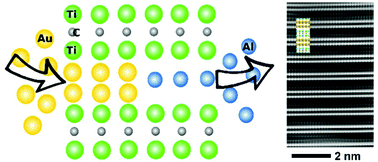Ti2Au2C and Ti3Au2C2 formed by solid state reaction of gold with Ti2AlC and Ti3AlC2†
Abstract
Incorporation of layers of noble metals in non-van der Waals layered materials may be used to form novel layered compounds. Recently, we demonstrated a high-temperature-induced exchange process of Au with Si in the layered phase Ti3SiC2, resulting in the formation of Ti3AuC2 and Ti3Au2C2. Here, we generalize this technique showing that Au/Ti2AlC and Au/Ti3AlC2 undergo an exchange reaction at 650 °C to form Ti2Au2C and Ti3Au2C2 and determine their structures by electron microscopy, X-ray diffraction, and ab initio calculations. These results imply that noble-metal-containing layered phases should be possible to synthesize in many systems. The metal to be introduced should be inert to the transition-metal carbide layers, and exhibit negative heat of mixing with the initial A element in a liquid phase or two-phase liquid/solid region at the annealing temperature.



 Please wait while we load your content...
Please wait while we load your content...